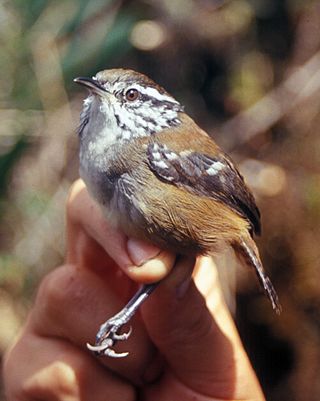
Wrens are a family of brown passerine birds in the predominantly New World family Troglodytidae. The family includes 88 species divided into 19 genera. Only the Eurasian wren occurs in the Old World, where, in Anglophone regions, it is commonly known simply as the "wren", as it is the originator of the name. The name wren has been applied to other, unrelated birds, particularly the New Zealand wrens (Acanthisittidae) and the Australian wrens (Maluridae).

The gnatcatchers are a family of small passerine birds called Polioptilidae. The 21 species occur in North and South America. Most species of this mainly tropical and subtropical group are resident, but the blue-grey gnatcatcher of the United States and southern Canada migrates south in winter. They are close relatives of the wrens.

The house wren is a very small bird of the wren family, Troglodytidae. It occurs from Canada to southernmost South America, and is thus the most widely distributed native bird in the Americas. It occurs in most suburban areas in its range and it is the single most common wren. Its taxonomy is highly complex and some subspecies groups are often considered separate species. The name troglodytes means "hole dweller", and is a reference to the bird's tendency to disappear into crevices when hunting insects or to seek shelter.

The rock wren is a small songbird of the wren family native to western North America, Mexico and Central America. It is the only species in the genus Salpinctes.

The superb fairywren is a passerine bird in the Australasian wren family, Maluridae, and is common and familiar across south-eastern Australia. It is a sedentary and territorial species, also exhibiting a high degree of sexual dimorphism; the male in breeding plumage has a striking bright blue forehead, ear coverts, mantle, and tail, with a black mask and black or dark blue throat. Non-breeding males, females and juveniles are predominantly grey-brown in colour; this gave the early impression that males were polygamous, as all dull-coloured birds were taken for females. Six subspecies groups are recognized: three larger and darker forms from Tasmania, Flinders and King Island respectively, and three smaller and paler forms from mainland Australia and Kangaroo Island.

The Munchique wood wren is a member of the wren family (Troglodytidae) that was described as new to science in 2003. It is found in the Western Andes of Colombia.

The white-breasted wood wren is a small songbird of the wren family. It is a resident breeding species from central Mexico to northeastern Peru and Suriname.

The band-backed wren is a small songbird of the wren family.

The gray-barred wren is a species of bird in the family Troglodytidae. It is endemic to Mexico.

The grey-breasted wood wren is a species of bird in the family Troglodytidae. It is found from Mexico to Bolivia.

The bar-winged wood wren is a species of bird in the family Troglodytidae. It is found in southern Ecuador and northern Peru.

The lovely fairywren, or lovely wren, is a species of bird in the Australasian wren family, Maluridae. It is endemic to northeastern Australia. Its natural habitats are subtropical or tropical dry forest and subtropical or tropical moist lowland forest.

The red-winged fairywren is a species of passerine bird in the Australasian wren family, Maluridae. It is non-migratory and endemic to the southwestern corner of Western Australia. Exhibiting a high degree of sexual dimorphism, the male adopts a brilliantly coloured breeding plumage, with an iridescent silvery-blue crown, ear coverts and upper back, red shoulders, contrasting with a black throat, grey-brown tail and wings and pale underparts. Non-breeding males, females and juveniles have predominantly grey-brown plumage, though males may bear isolated blue and black feathers. No separate subspecies are recognised. Similar in appearance and closely related to the variegated fairywren and the blue-breasted fairywren, it is regarded as a separate species as no intermediate forms have been recorded where their ranges overlap. Though the red-winged fairywren is locally common, there is evidence of a decline in numbers.

The grey-mantled wren is a species of bird in the family Troglodytidae. It is found in Bolivia, Colombia, Ecuador, and Peru.

The Naga wren-babbler or long-tailed wren-babbler is a bird species in the family Timaliidae. In India it is found in Nagaland and Manipur.

The grey wren is a species of bird in the family Troglodytidae. It is endemic to the southwestern part of Amazonas state in Brazil. This small, poorly known wren somewhat resembles a house wren, but its upperparts are gray.

The St Kilda wren is a small passerine bird in the wren family. It is a distinctive subspecies of the Eurasian wren endemic to the islands of the isolated St Kilda archipelago, in the Atlantic Ocean 64 kilometres (40 mi) west of the Outer Hebrides, Scotland.

The Eurasian wren or northern wren is a very small insectivorous bird, and the only member of the wren family Troglodytidae found in Eurasia and Africa (Maghreb). In Anglophone Europe, it is commonly known simply as the wren. It has a very short tail which is often held erect, a short neck and a relatively long thin bill. It is russet brown above, paler buff-brown below and has a cream buff supercilium. The sexes are alike.

The jungle babblers are a family, Pellorneidae, of mostly Old World passerine birds belonging to the superfamily Sylvioidea. They are quite diverse in size and coloration, and usually characterised by soft, fluffy plumage and a tail on average the length of their body, or longer. These birds are found in tropical zones, with the greatest biodiversity in Southeast Asia and the Indian subcontinent.

The hermit wood wren or Santa Marta wood wren is a species of bird in the family Troglodytidae. It is endemic to the Sierra Nevada de Santa Marta of northern Colombia.




















